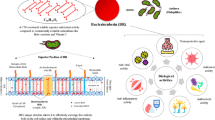Abstract
Chemical investigation of polar lipids from the marine eustigmatophyte microalga Nannochloropsis granulata led to the isolation of six betaine lipid diacylglyceryltrimethylhomoserine (DGTS), namely, (2S)-1,2-bis-O-eicosapentaenoylglyceryl-3-O-4′-(N,N,N-trimethyl)-homoserine (1), (2S)-1-O-eicosapentaenoyl-2-O-arachidonoylglyceryl-3-O-4′-(N,N,N-trimethyl)-homoserine (2), (2S)-1-O-eicosapentaenoyl-2-O-myristoylglyceryl-3-O-4′-(N,N,N-trimethyl)-homoserine (3), (2S)-1-O-eicosapentaenoyl-2-O-palmitoylglyceryl-3-O-4′-(N,N,N-trimethyl)-homoserine (4), (2S)-1-O-eicosapentaenoyl-2-O-palmitoleoylglyceryl-3-O-4′-(N,N,N-trimethyl)-homoserine (5), and (2S)-1-O-eicosapentaenoyl-2-O-linoleoylglyceryl-3-O-4′-(N,N,N-trimethyl)-homoserine (6). Structures of the isolated DGTSs were elucidated based on both spectroscopic technique and degradation methods. This is the first report of isolation of 1 in pure state, and 2–6 are all new compounds. The isolated betaine lipids showed dose-dependent nitric oxide (NO) inhibitory activity against lipopolysaccharide-induced nitric oxide production in RAW264.7 macrophage cells. Further study suggested that these betaine lipids (1–6) inhibit NO production in RAW264.7 macrophage cells through downregulation of inducible nitric oxide synthase expression, indicating the possible use as an anti-inflammatory agent. This is the first report of DGTS with anti-inflammatory activity.




Similar content being viewed by others
References
Abe S, Kaneda T (1975) Studies on effect of marine products on cholesterol metabolism in rat-XI, isolation of a new betaine, ulvaline, from a green laver Monostroma nitidum and its depressing effect on plasma cholesterol levels. Bull Jap Soc Sci Fish 41:567–571
Aktan F (2004) iNOS-mediated nitric oxide production and its regulation. Life Sci 75:639–653
Banskota AH, Gallant P, Stefanova R, Melanson R, O’Leary SJB (2012a) Monogalactosyldiacylglycerols, potent nitric oxide inhibitors from the marine microalga Tetraselmis chui. Nat Prod Res. doi:10.1080/14786419.2012.717285
Banskota AH, Stefanova R, Gallant P, McGinn P (2012b) Mono- and digalactosyldiacylglycerols; potent nitric oxide inhibitors from the marine microalga Nannochloropsis granulata. J Appl Phycol. doi:10.1007/s10811-012-9869-2
Brown AE, Elovson J (1974) Isolation and characterization of a novel lipid, 1(3),2-diacylglyceryl-(3)-O-4′-(N, N, N-trimethyl)homoserine, from Ochromonas danica. Biochemistry 13:3476–3482
Eichenberger W, Araki S, Müller DG (1993) Betaine lipids and phospholipids in brown algae. Phytochemistry 34:1323–1333
Fushiya S, Komatu Y, Nozoe S (1997) Two betaine type amino acid derivatives of Lampteromyces japonicus. Nat Med 51:558
Gils TD (2006) Aspects of nitric oxide in health and disease: a focus on hypertension and cardiovascular disease. J Clin Hypertens 8(12 Suppl 4):2–16
Guschina IA, Harwood JL (2006) Lipids and lipid metabolism in eukaryotic algae. Prog Lipid Res 45:160–186
Haigh WG, Yoder TF, Ericson L, Pratum T, Winget RR (1996) the characterization and cyclic production of a highly unsaturated homoserine lipid in Chlorella minutissima. Biochim Biophys Acta 1299:183–190
Kato M, Sakai M, Adachi K, Ikemoto H, Sano H (1996) Distribution of betaine lipids in marine algae. Phytochemistry 42:1341–1345
Kunzler K, Eichenberger W (1997) Betaine lipids and zwitterionic phospholipids in plants and fungi. Phytochemistry 46:883–892
Mooy BASV, Fredricks HF, Pedler BE, Dyhrman ST, Karl DM, Koblížek M, Lomas MW, Mincer TJ, Moore LR, Moutin T, Rappe MS, Webb EA (2009) Phytoplankton in the ocean use non-phosphorus lipids in response to phosphorus scarcity. Nature 458:69–72
Müller DG, Eichenberger W (1994) Betaine lipids content and species delimitation in Ectocarpus, Feldmannia and Hincksia (Ectocarpales, Phaeophyceae). Eur J Phycol 29:219–225
Nichols BW, Appleby RS (1969) The distribution and biosynthesis of arachidonic acid in algae. Phytochemistry 8:1907–1915
O’Donnell VB, Eiserich JP, Chumley PH, Jablonsky MJ, Krishna NR, Kirk M, Barnes S, Darley-Usmar VM, Freeman BA (1999) Nitration of unsaturated fatty acids by nitric oxide-derived reactive nitrogen species peroxynitrite, nitrous acid, nitrogen dioxide, and nitronium ion. Chem Res Toxicol 12:83–92
Sato N (1988) Dual role of methionine in the biosynthesis of diacylglyceryltrimethylhomoserine in Chlamydomonas reinhardtii. Plant Physiol 86:931–934
Sato N (1992) Betaine lipids. Bot Mag Tokyo 105:185–197
Acknowledgments
The authors are thankful to J. Milley, J. Hui, and Dr. J. Melanson for their technical support. This is NRC publication no. 50515.
Author information
Authors and Affiliations
Corresponding author
Rights and permissions
About this article
Cite this article
Banskota, A.H., Stefanova, R., Sperker, S. et al. New diacylglyceryltrimethylhomoserines from the marine microalga Nannochloropsis granulata and their nitric oxide inhibitory activity. J Appl Phycol 25, 1513–1521 (2013). https://doi.org/10.1007/s10811-012-9967-1
Received:
Revised:
Accepted:
Published:
Issue Date:
DOI: https://doi.org/10.1007/s10811-012-9967-1




